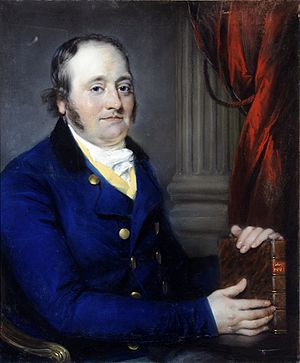John Marshall (industrialist) facts for kids
Quick facts for kids
John Marshall
|
|
|---|---|

artist John Russell 1802
|
|
| Born | 27 July 1765 Briggate, Leeds, England
|
| Died | 6 June 1845 Hallsteads, Watermillock, England
|
| Occupation | Textile Industrialist Politician |
| Known for | Marshall's Mill Temple Works |
John Marshall (born 1765, died 1845) was an important British businessman and politician. He came from Leeds, a city in West Yorkshire, England. He was known for his large flax mills and for being a Member of Parliament.
Contents
John Marshall's Early Life
John Marshall was born on July 27, 1765, in Leeds. He was the only child of Jeremiah and Mary Marshall to survive past infancy. His father, Jeremiah, was a linen draper, which means he sold linen fabric.
When John was 17, he joined his family's business. Five years later, his father passed away. John then took over the company. He inherited a new house, a warehouse, and a good amount of money.
Discovering New Technology
Before his father died, John heard about a new invention. Two men from Darlington, John Kendrew and Thomas Porthouse, had created a new machine. This machine could spin flax, which is a plant fiber used to make linen.
Marshall visited these inventors. He bought the right to make copies of their new machine. For the next ten years, he worked hard to make the machines better. He didn't have much success until he hired a skilled engineer named Matthew Murray.
Building a Business Empire
In 1790, Marshall bought a piece of land in Holbeck, near Leeds. This spot was perfect for a mill. It was close to the Leeds and Liverpool Canal and the Aire and Calder Navigation. These canals were like highways for boats. They made it easy to transport goods.
Marshall's Mill
Between 1791 and 1792, Marshall built his first big factory, Marshall's Mill. It was a six-story building. The mill used water from the nearby Hol Beck to power its machines. This water power helped spin flax into yarn.
Marshall's Mill was very successful. It had enough power to run 7,000 spindles. A spindle is a part of a machine that twists fibers into yarn. The mill employed 2,000 factory workers. Just one generation before, making yarn was mostly done by hand in homes. This was a big change!
The First Iron-Framed Building
In 1796, Marshall worked with other partners on a special project. They built a flax mill in Ditherington, near Shrewsbury. This mill was the first building in the world to have an iron frame. This was a huge step forward in building design.
Temple Works
Marshall built his most impressive factory, Temple Works, next to Marshall's Mill. He started building it in 1836, and it was finished in 1840. Temple Works was designed to look like the ancient Temple of Edfu in Egypt. Even its chimney looked like an Egyptian obelisk.
At the time, Temple Works was said to have the largest single room in the world. Workers there often worked 72 hours a week. Many of Marshall's employees were young women aged 13 to 20. About 20% of his workers were even younger than 13.
The conditions in flax mills were very hot and humid. This was because of the many workers and because humidity made the flax easier to work with. Even with these conditions, Marshall was seen as a fair factory owner. He was more liberal than many others during the Industrial Revolution. For example, his managers were not allowed to hit workers. Younger children were encouraged to go to school during the day. Older children received free education on Monday afternoons.
Public Service and Retirement
John Marshall cared about education and community. He helped start the Leeds Mechanics' Institute. This place taught working people about science and technology. He also helped create the Leeds Philosophical and Literary Society, which promoted learning. In 1826, he began a campaign to establish Leeds University. Marshall also gave money to the Leeds Library.
In 1821, Marshall became the High Sheriff of Cumberland. This was an important local role. In 1826, he was elected as a Member of Parliament for Yorkshire. This meant he represented the area in the House of Commons, which is part of the UK government.
In 1830, Marshall resigned from Parliament due to poor health. He retired to his country home, Hallsteads. He had built this home in 1815 near Watermillock, by Ullswater lake in the Lake District. Today, Hallsteads is used as the Ullswater Outward Bound Centre, which helps young people develop through outdoor challenges.
John Marshall passed away at Hallsteads in 1845. He was buried in the church next to his home.
Marshall's Family
John Marshall married Jane Pollard. Her father was a wool and linen merchant from Halifax. John and Jane had eleven children.
Several of their sons followed in their father's footsteps and became politicians:
- Their oldest son, William, was a Member of Parliament for different areas.
- Their second son, John, was an MP for Leeds from 1832 to 1835.
- Their third son, James Garth, also held the Leeds MP seat later on.
- Their fourth son, Henry Cowper, became the Mayor of Leeds.
Their daughter, Julia Anne, wrote words for several hymns.

